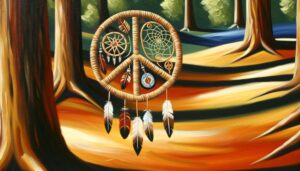Crafting with Meaning: Celtic Symbols of Strength in Design
Celtic symbols for strength, such as the Dara Knot and the Ailm, draw from the ancient cultural reverence for natural elements. The Dara Knot, rooted in the oak tree, signifies stability and inner strength, encapsulating the enduring power of nature.
The Ailm, associated with the fir tree, symbolizes resilience, healing, and endurance. These symbols interweave intricate designs with deep meanings that reflect the Celtic worldview on fortitude.
Contemporary interpretations have reimagined these symbols to align with modern values of personal empowerment and resilience. To uncover the extensive influence and contemporary adaptations of these powerful symbols, continue exploring their rich cultural tapestry.
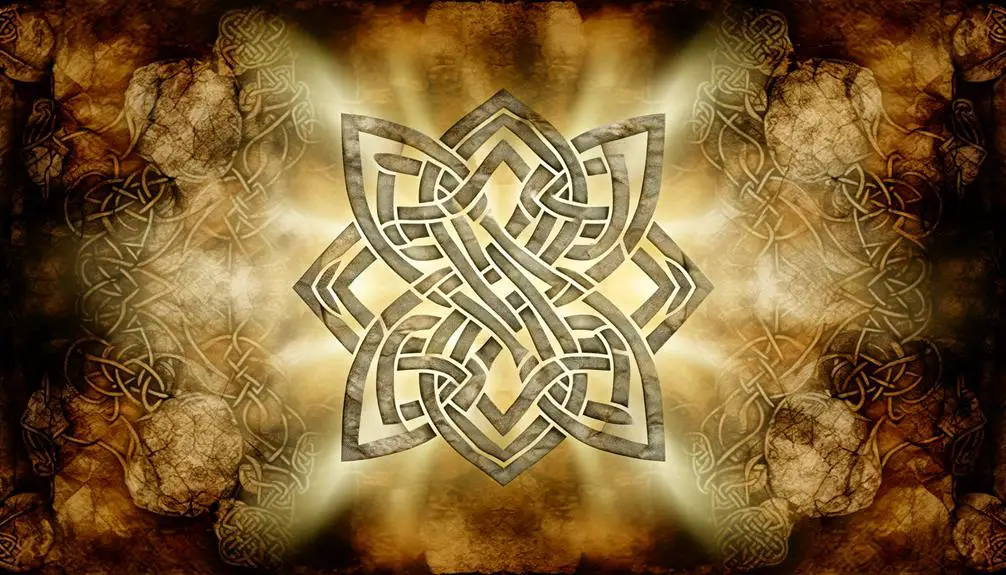
Key Takeaways
- The Dara Knot symbolizes stability, endurance, and inner strength, rooted in the reverence for the oak tree.
- The Ailm symbol represents strength, resilience, and healing, linked to the fir tree and the Ogham alphabet.
- The Triskelion embodies physical, mental, and spiritual strength, emphasizing a holistic approach to resilience.
- Celtic symbols like knots and spirals are metaphors for life's challenges and personal fortitude in contemporary times.
- Celtic tattoos featuring knots and animal motifs depict attributes of strength and serve as personal emblems of overcoming adversity.
Origins of Celtic Symbols
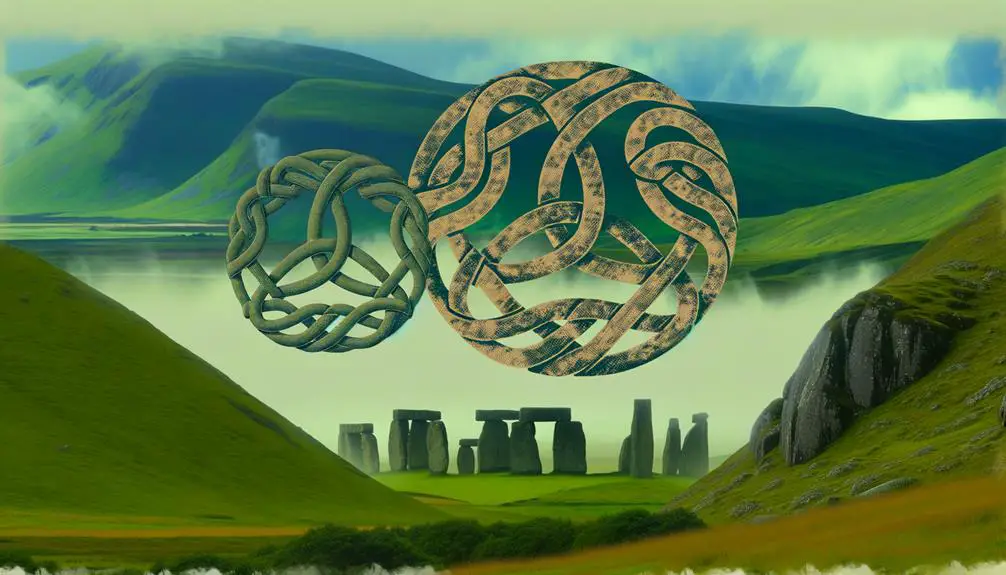
Frequently rooted in the ancient traditions and spiritual practices of the Celts, the origins of Celtic symbols can be traced back to a rich tapestry of cultural and historical influences that span several millennia.
These symbols were often intertwined with the natural world, reflecting the Celts' deep reverence for nature. Artifacts such as stone carvings, metalwork, and manuscripts illustrate the early use of intricate patterns and motifs.
The Celts, a collection of tribes with shared linguistic and cultural traits, inhabited regions across Western Europe. Through trade and conquest, their symbolic lexicon was influenced by neighboring cultures.
These interactions shaped a unique iconographic tradition that conveyed complex concepts, such as strength, through abstract, often geometric designs.
Cultural Significance
The intricate designs and motifs of Celtic symbols, deeply rooted in the rich historical tapestry of the Celts, carry profound cultural significance that extends beyond mere decoration to embody values such as strength, unity, and spiritual connection.
These symbols, often found in ancient manuscripts, stone carvings, and jewelry, serve as visual narratives of the Celtic worldview. For the Celts, strength was not merely physical but also moral and spiritual, intertwined with resilience and fortitude.
The cultural significance lies in how these symbols encapsulate communal values and shared beliefs, acting as conduits for conveying complex ideas and emotions. Their enduring appeal highlights the Celts' profound respect for nature, the cosmos, and the interconnectedness of all life, reflecting a holistic understanding of strength.
Common Symbols for Strength
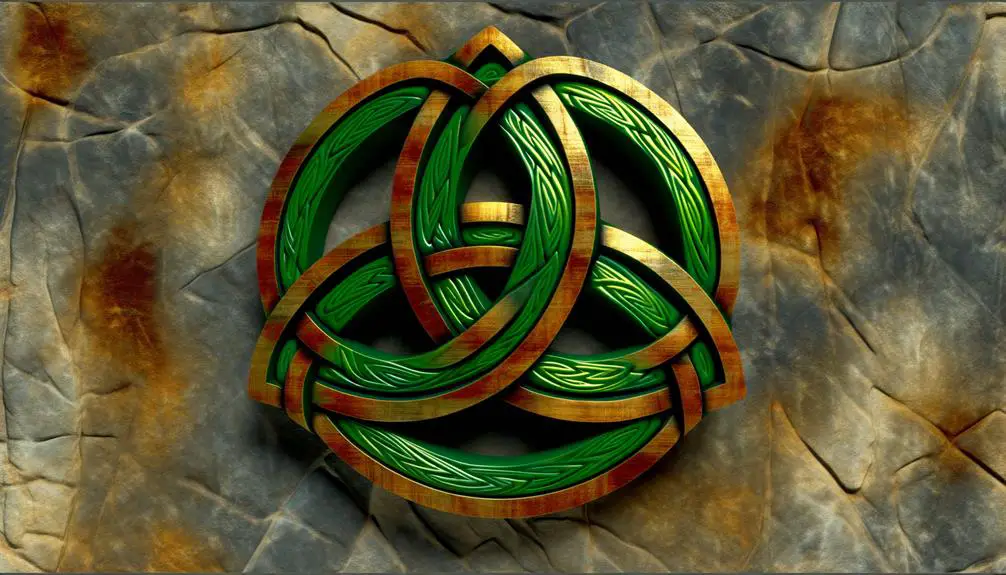
Among the array of Celtic symbols that epitomize strength, the Dara Knot stands out as a prominent representation, deeply intertwined with the ancient oak tree and its symbolic association with endurance and resilience.
Beyond the Dara Knot, several other symbols are widely recognized for their embodiment of strength within Celtic culture. The Ailm, for example, is derived from the letter 'A' in the Ogham alphabet and signifies strength, endurance, and healing.
The Oak Tree itself, often depicted alone, is another powerful symbol, revered for its robust nature and longevity.
Additionally, the Triskelion, with its three interlocking spirals, represents the unity of physical, mental, and spiritual strength, illustrating a holistic approach to resilience and fortitude.
The Dara Knot
Rooted in the ancient reverence for the oak tree, the Dara Knot is a quintessential Celtic symbol that encapsulates profound themes of inner strength and resilience.
The name 'Dara' derives from the Gaelic word 'Doire,' meaning 'oak tree,' which held significant spiritual and cultural importance in Celtic tradition.
The intricate, interwoven design of the Dara Knot mirrors the complex root systems of the oak, symbolizing stability, endurance, and a connection to one's inner strength.
This motif serves as a visual reminder of one's ability to withstand adversity and remain grounded amidst life's challenges.
The oak's storied presence in Celtic mythology underscores its role as a metaphor for personal growth and unwavering fortitude, making the Dara Knot a powerful emblem of strength.
The Ailm Symbol
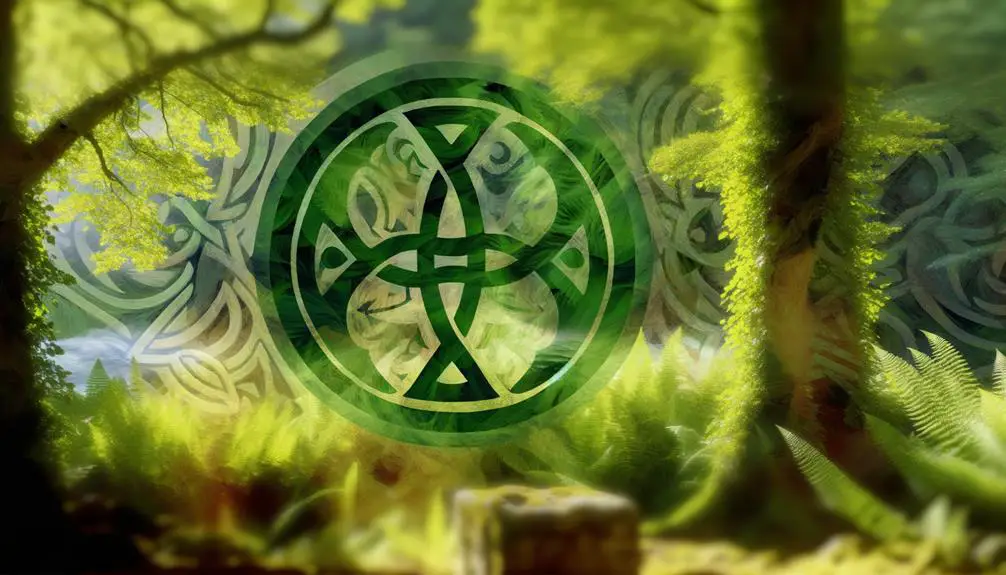
The Ailm symbol, rooted in ancient Celtic traditions, represents strength through its connection to the fir tree, known for its resilience and steadfastness.
Historically, it has been linked to physical and spiritual healing, reflecting the Celts' deep reverence for nature.
In contemporary contexts, the Ailm is frequently adopted in personal and artistic expressions, symbolizing inner fortitude and enduring growth.
Symbolic Origins and History
Although widely regarded as a potent emblem of strength, the Ailm symbol's origins trace back to ancient Celtic traditions where it was intricately linked with natural elements and spiritual renewal.
Rooted in the Ogham alphabet, the Ailm represented the letter 'A' and was associated with coniferous trees, symbolizing resilience and endurance. Its circular design, often interpreted as a cross within a circle, signifies balance and the cyclical nature of life.
This iconography encapsulated the Celts' profound reverence for nature and their belief in the interconnectedness of all living things.
Historically, the Ailm was not just a linguistic character but a spiritual emblem, embodying the enduring strength found in nature and the perpetual cycle of growth and renewal.
Modern Interpretations and Uses
In contemporary times, the Ailm symbol has transcended its ancient Celtic origins to become a widely recognized emblem of personal and spiritual fortitude. It is often utilized in modern art, jewelry, and tattoo designs to invoke its historical connotations of resilience and interconnectedness.
This transformation is fueled by a growing interest in symbolism and ancient wisdom in a fast-paced modern world. Artists and designers frequently incorporate the Ailm into their work to provide a touchstone of strength and unity, resonating deeply with individuals seeking inner peace and balance.
Moreover, its use in tattoos represents a permanent, personal commitment to embodying the steadfastness and holistic harmony the symbol traditionally signifies. This bridges ancient tradition with contemporary self-expression.
Interpretation Through History
The interpretation of Celtic symbols for strength has evolved greatly from their ancient origins, where they were deeply intertwined with Druidic rituals and natural elements, to their roles in medieval heraldry.
Over centuries, the cultural significance of these symbols has transformed, reflecting broader societal changes and the shifting values of Celtic communities.
Today, modern interpretations often emphasize personal empowerment and resilience, highlighting a notable shift from their historical communal and spiritual meanings.
Ancient Symbolism Origins
Dating back to the Iron Age, the Celtic symbol for strength has evolved through a rich tapestry of cultural and historical contexts, offering profound insights into the values and beliefs of ancient Celtic societies. The Celts held a deep reverence for natural elements and deities, embodying strength through intricate knotwork and animal motifs. Analyzing these symbols reveals their multifaceted significance.
| Symbol | Interpretation |
|---|---|
| Dara Knot | Inner strength and resilience |
| Ailm | Coniferous tree symbolizing growth |
| Boar | Bravery, power, and protection |
These symbols were not merely decorative; they encapsulated the ethos of endurance, growth, and protection. By examining these ancient icons, we gain a nuanced understanding of how the Celts conceptualized strength in both personal and communal spheres.
Cultural Significance Evolution
Frequently evolving through centuries, the cultural significance of Celtic symbols for strength has been shaped by historical events, sociopolitical changes, and ongoing reinterpretations within various communities. Initially tied to warrior cultures and tribal identities, these symbols encapsulated resilience and unity.
The spread of Christianity across Celtic regions introduced new dimensions, blending pagan and Christian iconography. Medieval manuscripts and artifacts reveal how these symbols were adapted for religious and political purposes, often embodying divine protection.
The resurgence of interest in Celtic heritage during the 19th and 20th centuries further transformed their meanings, as they became emblems of cultural revival and national pride. The Celtic symbols for strength reflect a dynamic interplay between tradition and transformation across different historical epochs.
Modern Interpretations Shift
As we move into contemporary times, the interpretation of Celtic symbols for strength continues to evolve, reflecting the complexities of modern identities and global cultural exchanges.
Today, these ancient symbols are often reimagined to resonate with personal empowerment, resilience, and spiritual growth. The globalization of culture has allowed Celtic symbols to transcend their original geographic confines, becoming universal emblems adopted by diverse communities.
This shift mirrors a broader trend where historical symbols are repurposed to meet contemporary needs, blending ancient wisdom with modern sensibilities. The intricate knots and patterns, once markers of tribal affiliation and spiritual beliefs, now serve as timeless motifs in tattoos, jewelry, and art, symbolizing an enduring and adaptable form of strength across epochs.
Modern-Day Meanings
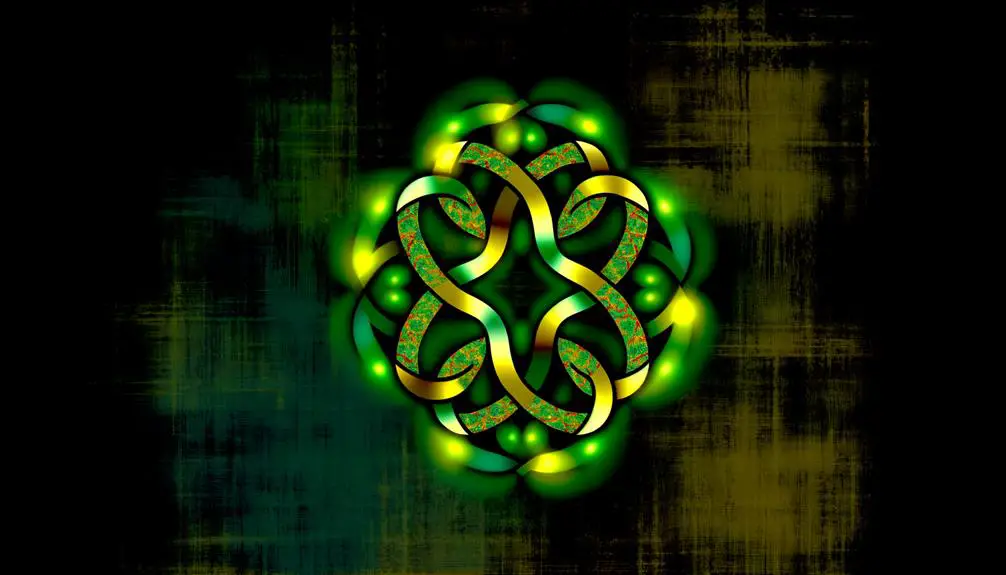
In contemporary contexts, the Celtic symbol for strength is often interpreted as a representation of resilience, inner fortitude, and the enduring human spirit. This shift in meaning aligns with modern values of personal empowerment and self-overcoming.
The intricate designs, often involving interconnected knots or spirals, are seen as metaphors for life's complex challenges and the strength required to navigate them. The perpetual loops symbolize an unbreakable will and the continuous journey of growth and learning.
Additionally, the symbol's historical roots imbue it with a sense of timeless wisdom, providing individuals with a connection to ancient cultural heritage while fostering a sense of identity and purpose in today's fast-paced world. Hence, its modern-day significance is both profound and multifaceted.
Symbolism in Tattoos
The profound and multifaceted significance of the Celtic symbol for strength has made it a popular choice for tattoos. Its intricate designs and deep meanings serve as personal emblems of resilience and endurance. Tattoo enthusiasts are drawn to these symbols for their historical depth and the layered meanings they convey.
The knotwork and spirals, hallmarks of Celtic design, embody a continuous journey and interconnectedness, reflecting an individual's personal narrative of overcoming adversity. In this situation, the tattoos are not merely decorative but serve as powerful reminders of one's inner fortitude and heritage.
The choice of placement and specific design elements further personalize the experience, adding layers of intention and storytelling to the symbolic art.
Celtic Art and Strength
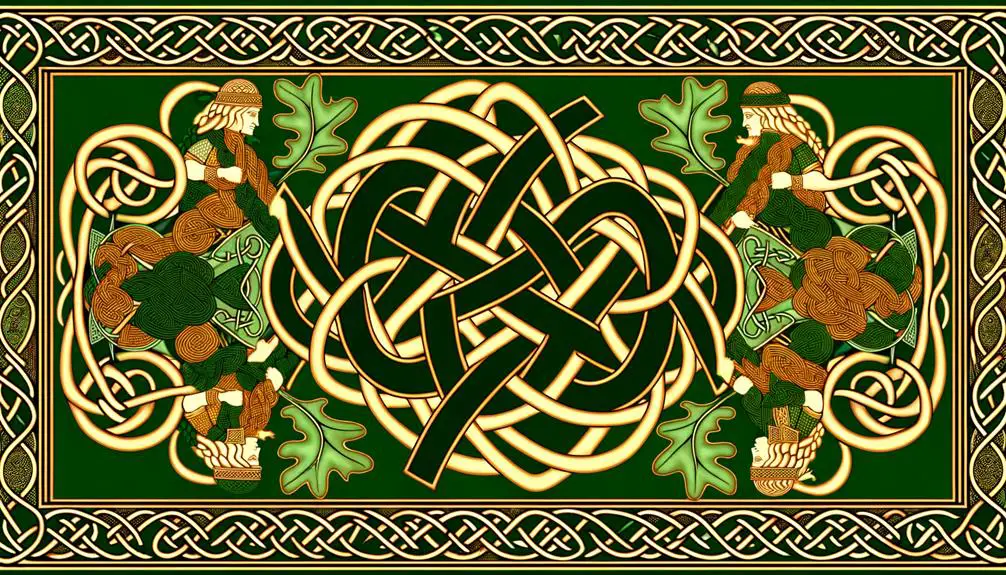
Celtic art, with its intricate knotwork, spirals, and animal motifs, not only showcases exceptional craftsmanship but also embodies the cultural essence of strength that is woven into the fabric of Celtic identity. This art form serves as a visual representation of resilience and unity, reflecting the interconnectedness of life and nature. The complexity and continuity found in Celtic designs symbolize endurance and the eternal nature of the human spirit.
- Knotwork: Represents the unbroken cycle of life and the strength found in continuity.
- Spirals: Symbolize growth, progress, and the cyclical nature of existence.
- Animal motifs: Depict various attributes of strength, such as courage and protection.
- Interlacing patterns: Emphasize unity and interconnectedness.
- Triskele: A triple spiral signifying balance, harmony, and strength.
This rich symbolic language underlines the importance of strength within Celtic culture.
Strength in Celtic Mythology
Drawing from the rich tapestry of Celtic art, mythology further amplifies the theme of strength through its pantheon of gods, legendary heroes, and mythical creatures, each embodying distinct aspects of power and resilience. The warrior deity Lugh, renowned for his multifaceted skills, symbolizes versatility. Cú Chulainn, a hero of the Ulster Cycle, epitomizes unyielding bravery and martial prowess. The Morrígan, a shape-shifting goddess, represents strategic warfare and fate.
| Figure | Aspect of Strength | Symbolism |
|---|---|---|
| Lugh | Versatility | Mastery in multiple disciplines |
| Cú Chulainn | Bravery and Martial Prowess | Legendary feats in battle |
| The Morrígan | Strategic Warfare and Fate | Control over life, death, and destiny |
| Dagda | Physical Power | Possession of a magical club and cauldron |
These figures collectively portray a multifaceted interpretation of strength in Celtic mythology.
Conclusion
To sum up, Celtic symbols for strength, like the Dara Knot and the Ailm, serve as profound cultural beacons, illuminating the values and beliefs of ancient Celtic society.
Just as a tree's roots anchor it firmly to the earth, these symbols ground contemporary interpretations in a rich historical context.
Their continued relevance in modern tattoos and art underscores a timeless quest for resilience and fortitude, bridging the ancient past with the present.






